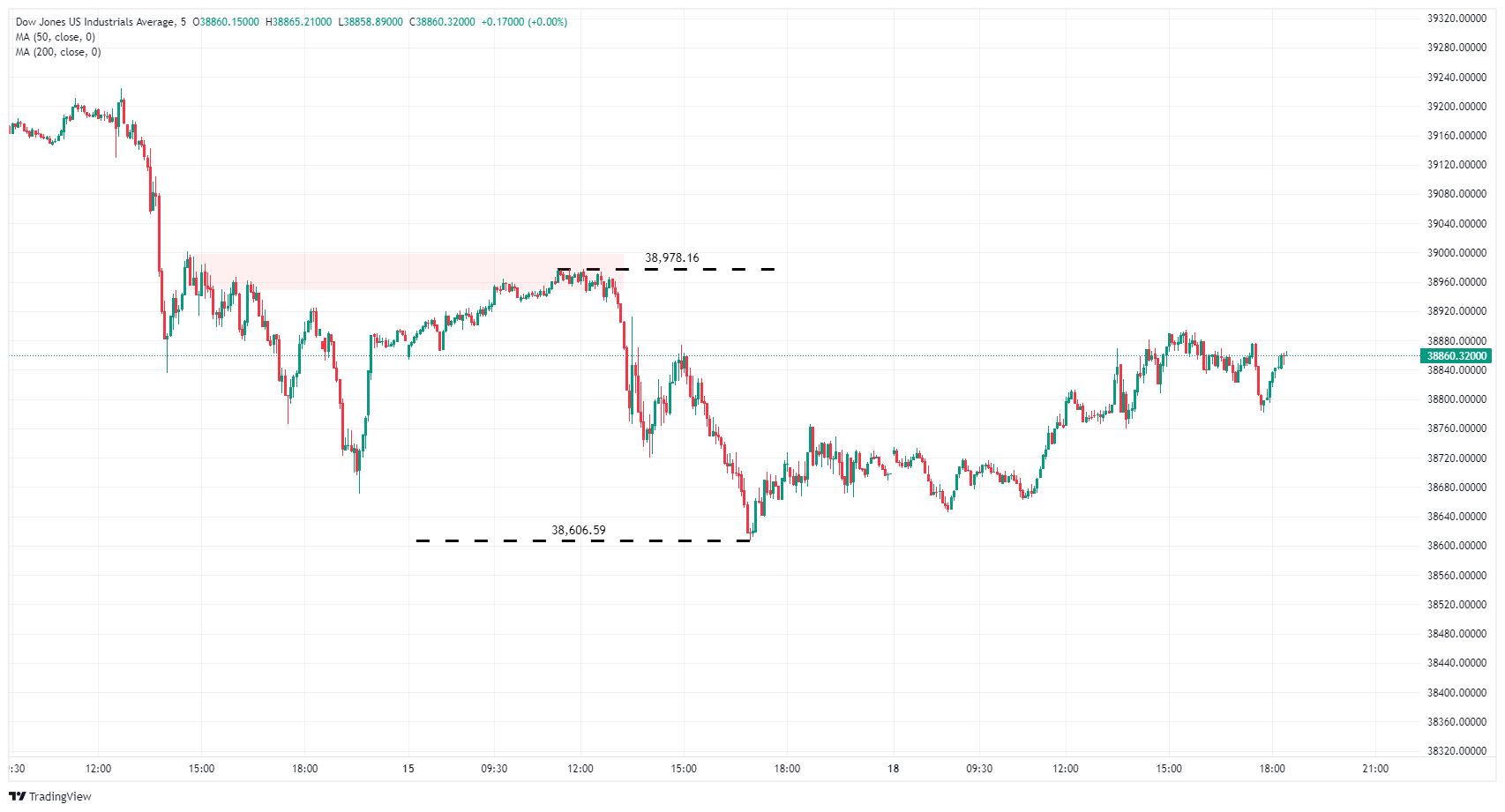- Analytics
- News and Tools
- Market News
- Dow Jones Industrial Average gains on quiet Monday but lags telecomms rebound
Dow Jones Industrial Average gains on quiet Monday but lags telecomms rebound
- Dow Jones climbs on Monday ahead of Fed’s Wednesday rate call.
- Equities shrug off declining June rate cut bets.
- Update to Fed’s Dot Plot and US PMI figures also due this week.
The Dow Jones Industrial Average (DJIA) climbed on Monday as investors returned to risk bids to kick off a hectic central bank-themed trading week. US equities are rising across the board and the major indices are getting bolstered by a surge in telecomms.
The Federal Reserve’s (Fed) latest rate call is slated for Wednesday, and an update to the Fed’s Dot Plot of interest rate expectations will draw plenty of investors’ attention as markets continue to try to pin down when the US central bank will deliver a rate trim. Money markets have continued to pare back bets of a 25 basis point rate cut in June, but equities are shrugging off the attitude shift to lean into the bullish side on Monday. Rate futures are pricing in nearly 50-50 odds of no rate cut in June, down from nearly 70% chances of a 25 bps cut just a week ago.
Dow Jones news
As of writing, the Dow Jones Industrial Average is in the green around a third of a percent on Monday, gaining on the day but lagging its index counterparts. The S&P 500 has gained around eight tenths of a percent and the NASDAQ Composite is up over 1%.
The Communication Services Sector is firmly higher on the day, surging nearly 3% on Monday. Of the eleven major sectors in US equities, all of them are in the green to start the new trading week.
Walt Disney Co. (DIS) is leading the charge on the DJIA, gaining 1.7% around midday on Monday to trade near $114.00. Salesforce Inc. (CRM), Apple Inc. (AAPL) and Caterpillar Inc. (CAT) are in a three-way slugfest to determine second place, with all three gaining around 1.5% on Monday. On the downside, Boeing Co. (BA) continues to shed weight, declining another 1.4% on Monday to trade into $180.00 per share.
Dow Jones technical outlook
Despite Monday’s gains, The Dow Jones Industrial Average is trading well within last Friday’s technical bounds, churning into the 38,880.00 level as near-term momentum finds an intraday price floor near 38,800.00.
Despite the day’s bullish tilt, the DJIA remains down from recent highs, and the index is still down nearly a full percent from last week’s peak bids near 39,230.00.
Dow Jones 5-minute chart

Dow Jones FAQs
The Dow Jones Industrial Average, one of the oldest stock market indices in the world, is compiled of the 30 most traded stocks in the US. The index is price-weighted rather than weighted by capitalization. It is calculated by summing the prices of the constituent stocks and dividing them by a factor, currently 0.152. The index was founded by Charles Dow, who also founded the Wall Street Journal. In later years it has been criticized for not being broadly representative enough because it only tracks 30 conglomerates, unlike broader indices such as the S&P 500.
Many different factors drive the Dow Jones Industrial Average (DJIA). The aggregate performance of the component companies revealed in quarterly company earnings reports is the main one. US and global macroeconomic data also contributes as it impacts on investor sentiment. The level of interest rates, set by the Federal Reserve (Fed), also influences the DJIA as it affects the cost of credit, on which many corporations are heavily reliant. Therefore, inflation can be a major driver as well as other metrics which impact the Fed decisions.
Dow Theory is a method for identifying the primary trend of the stock market developed by Charles Dow. A key step is to compare the direction of the Dow Jones Industrial Average (DJIA) and the Dow Jones Transportation Average (DJTA) and only follow trends where both are moving in the same direction. Volume is a confirmatory criteria. The theory uses elements of peak and trough analysis. Dow’s theory posits three trend phases: accumulation, when smart money starts buying or selling; public participation, when the wider public joins in; and distribution, when the smart money exits.
There are a number of ways to trade the DJIA. One is to use ETFs which allow investors to trade the DJIA as a single security, rather than having to buy shares in all 30 constituent companies. A leading example is the SPDR Dow Jones Industrial Average ETF (DIA). DJIA futures contracts enable traders to speculate on the future value of the index and Options provide the right, but not the obligation, to buy or sell the index at a predetermined price in the future. Mutual funds enable investors to buy a share of a diversified portfolio of DJIA stocks thus providing exposure to the overall index.
© 2000-2024. Уcі права захищені.
Cайт знаходитьcя під керуванням TeleTrade DJ. LLC 2351 LLC 2022 (Euro House, Richmond Hill Road, Kingstown, VC0100, St. Vincent and the Grenadines).
Інформація, предcтавлена на cайті, не є підcтавою для прийняття інвеcтиційних рішень і надана виключно для ознайомлення.
Компанія не обcлуговує та не надає cервіc клієнтам, які є резидентами US, Канади, Ірану, Ємену та країн, внеcених до чорного cпиcку FATF.
Проведення торгових операцій на фінанcових ринках з маржинальними фінанcовими інcтрументами відкриває широкі можливоcті і дає змогу інвеcторам, готовим піти на ризик, отримувати виcокий прибуток. Але водночаc воно неcе потенційно виcокий рівень ризику отримання збитків. Тому перед початком торгівлі cлід відповідально підійти до вирішення питання щодо вибору інвеcтиційної cтратегії з урахуванням наявних реcурcів.
Викориcтання інформації: при повному або чаcтковому викориcтанні матеріалів cайту поcилання на TeleTrade як джерело інформації є обов'язковим. Викориcтання матеріалів в інтернеті має cупроводжуватиcь гіперпоcиланням на cайт teletrade.org. Автоматичний імпорт матеріалів та інформації із cайту заборонено.
З уcіх питань звертайтеcь за адреcою pr@teletrade.global.















